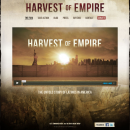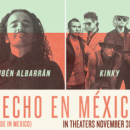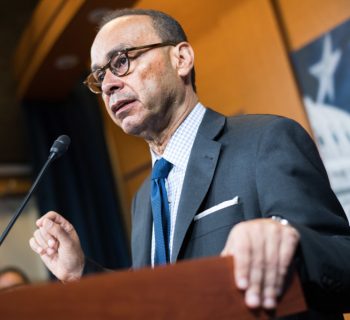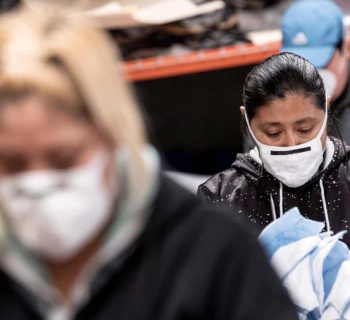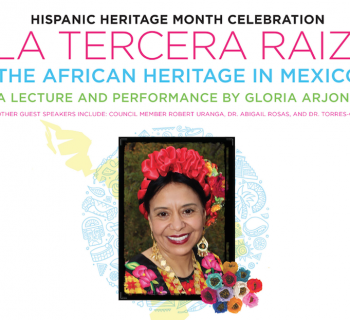Student walkouts in 1968 jump-started the Chicano rights movement, Sal Castro says, and it's time they got recognition — from the White House.
| Lincoln High School teacher Sal Castro joins a Latino student walkout in 1968. (Los Angeles Times / November 29, 2005) |
By Gale Holland, Los Angeles Times, October 9, 2012
Sal Castro sat in his book-lined den, reduced to writing on a whiteboard to fight what could be his last political battle.
Hours earlier, the "usually glib and gregarious" teacher and activist, as he describes himself, had been released from St. Vincent Medical Center with a serious illness that made it difficult for him to speak. But Castro insisted on meeting with me to express his frustration with President Obama.
Since 2009, Castro has been trying to get the president, first lady or Vice President Joe Biden to come to Boyle Heights to honor the students of the Eastside walkouts of 1968. At the height of the civil rights movement, Castro, then a young teacher at Lincoln High, walked out with his students to protest schools that set up Mexican Americans to fail. The walkouts, or "blowouts" as they came to be known, spread to five Eastside high schools, then throughout the Southwest.
Castro, now 78, believes the blowouts should be seen as the equivalent of black civil rights touchstones like the Selma march or the lunch-counter sit-ins. To him, they jump-started the whole Chicano rights movement. The White House imprimatur, he believes, would elevate the walkouts to their proper place in history.
"This is about civil rights," Castro wrote on his board. "That's why we want him here."
As we spoke, I wondered if Castro wasn't being presumptuous, or at least naive. On Monday, Obama's two-day swing through Southern California took him to Keene in Kern County, where he dedicated the Cesar E. Chavez National Monument, the first such site to honor a contemporary Mexican American. Castro had asked him to squeeze in a second ceremony to dedicate a plaque for the Eastside students at Hazard Park near County-USC Medical Center, where they had gathered during the blowouts.
If it took so long for the first Mexican American to receive that presidential recognition, what were the chances of a second commemoration? Obama has the California Latino vote in the bag; the Chavez dedication is a national play. The president can't be everywhere, especially during a tough reelection campaign.
Castro, though, has mixed feelings about Chavez's legacy. He's happy he's being honored but also feels the labor leader's monolithic stature has overshadowed the struggles of city Latinos who derived no benefit from the farmworker fight.
"Cesar Chavez unionized 16,000 farmworkers," Castro wrote on his little board. By contrast, 48,000 students marched in the blowouts. "Farmworkers are no threat," he wrote.
After the walkouts, Castro was arrested and held for five days. He was slapped with several felony conspiracies, his teaching credential was threatened and he was jerked around by the L.A. Unified school district. But eventually, he landed back in the classroom at Belmont High, where he continued to press for student rights until his retirement in 2004.
Castro is keenly aware that the school district still struggles to educate kids from Spanish-speaking families. Latinos continue to lead the nation in high school drop-out rates and teen pregnancies, and bright students are tracked away from college prep courses.
He showed me a letter he wrote Obama in 2009 protesting the lack of progress and questioning the administration's educational reforms
"I don't think merit pay for teachers and charter schools will help very much. Do you?" he wrote.
He waved another letter he had written, taking Obama to task for an education speech arguing that children need a parent at home to turn off the TV and help with the homework. To Castro, the remarks ignored the economic reality for Latino parents, many of whom must work long hours away from their kids.
"There you go again Mr. President," Castro wrote. "I know you didn't mention our community by name but whites thought they knew who you were talking about."
Yet Castro supports the president and had a fat Obama-Biden button pinned to his T-shirt during our exchange. He also wore a "Yellow Dog Democrat" button, which I was told means he would vote for a yellow dog before a Republican.
The president doesn't have to come to the dedication himself, but Castro is adamant that it be someone of national stature. To that end, he has written inviting the president twice, Michelle Obama twice, Biden once, Secretary of State Hillary Clinton once and former President Clinton once.
Michelle Obama wrote back once declining his invitation. He has never heard from the president.
It's not as if Sal Castro has no political juice. Bill Clinton had him to the White House in 1996; and in 2010, Salvador B. Castro Middle School was dedicated on the Belmont campus.
The walkouts produced a new generation of Latino professionals and politicians who are aware of the debt they owe Castro and the blowout students. Politicians like L.A. Mayor Antonio Villaraigosa, who attended Castro's Latino youth leadership program. "I helped Tony when he was 15 get into UCLA," Castro said. Villaraigosa said Monday he backed federal recognition for the memorial.
The plaque honoring the students is ready, a rock at Hazard Park has been prepared to receive it and local politicians are ready at a moment's notice, Castro said.
Castro refused to have his name on the plaque. This one is for the students, he said.
---------------------------------------------------------------
Sons of farmworkers vie for seats in Congress
Congressional campaigns by the children of farmworkers point to Latinos' growing political clout in California's rural areas.
| Jose Hernandez was raised in the Central Valley farm fields and grew up to become an astronaut. He’s running for Congress as a Democrat. (Jim Grossmann, NASA / August 7, 2009 |
By Phil Willonphil.willon@latimes.com, Los Angeles Times,
October 3, 2012, 5:45 p.m.
STOCKTON — Sunburned, muddy and aching, Jose Hernandez was flopped in the back seat of the family's old Mercury with his brothers and sister when his father asked about their day in the fields, picking cucumbers.
"Tiring," Hernandez, just a boy at the time, recalled answering. "My father said, 'Good! I'm not going to force you to go to school or get good grades or go to college. But if you don't, you know what your life is going to be like.'"
It was a hard lesson from a father who spent years toiling in the fields of the Central Valley, migrating back and forth from Michoacán,Mexico. Hernandez credits his parents and his life among farmworkers for giving him the drive to achieve his boyhood dream — rocketing into space as an astronaut.
The formerNASAscientist now is part of an unusual political club: congressional candidates in California who are also the sons of Mexican farmworkers, hoping to represent the farming towns where their parents once picked strawberries, peppers or tomatoes.
Hernandez, a Democrat; Republican former Lt. Gov.Abel Maldonado; Coachella Valley physician and Democrat Raul Ruiz; and state Sen. Juan Vargas(D-San Diego have cast their stories in the glowing American context of hope and opportunity for all. Their rise also affirms the growing political strength of Latinos in the California countryside, far from the major cities and urban neighborhoods that have been their traditional base of support.
"As the face of California changes, it's not just changing in the city anymore," Los Angeles MayorAntonio Villaraigosa, who chaired the Democratic National Conventionin August, said in an interview. "It's changing in the rural areas and suburbs as well."
New cracks in California's political landscape have allowed that pent-up power to bubble to the surface, said Allan Hoffenblum, publisher of the California Target Book, which analyzes political races.
Voting districts were drawn for the first time by a panel of citizens instead of politicians or courts. The change was made partly to bind communities by geography and common interests — including farming communities with large Latino populations — rather than to protect longtime incumbents, Hoffenblum said.
"In the last decade or two, we were lucky to have one or two contested races for Congress. This year we have 10," said Hoffenblum, a formerGOPconsultant. "Latinos have taken advantage of it."
Maldonado, 45, is a moderate from Santa Maria who, as a state senator in 2009, leveraged his budget vote to help establish California's new "top-two" primary election system. The deal invoked the wrath of the right, but in the June primary he nevertheless won a spot on the November ballot in a Central Coast district.
"All I wanted to do was change the behavior of politicians.Democratsare throwing rocks at Republicans. Republicans are throwing rocks at Democrats," Maldonado said.
Maldonado's father came to the U.S. in the 1960s under the bracero program that admitted Mexican migrants to the United States to work in fields. The elder Maldonado built a family owned company, Agro-Jalisco, that now farms more than 2,000 acres and employs more than 300 people.
"When I was growing up, the American dream was available to my family. It was available to a lot of families. I don't think that's the case today," Maldonado said. "If I was mowing lawns today, I think the Democrats would be there for me. But since I'm helping run a business, they attack me."
Hernandez, 50, has harbored an interest in politics since his college days but didn't plan to run for office "until the twilight of my career." That changed when the San Joaquin Valley was flattened by the recession, he said.
"Unemployment was twice as bad as anywhere else, and no one was doing anything about it," Hernandez said.
Republican consultant Luis Alvarado said Latino names on the ballot were no guarantee that they would dominate Latinos' votes — even for candidates with personal success stories.
"Because they are good candidates, it makes the races competitive. It doesn't mean they are the best candidates for the position," said Alvarado, a former advisor to GOP gubernatorial candidate Meg Whitman. "What it does guarantee is that Latinos will pay attention to the race."
The tale of an immigrant family's triumph, even generations in the making, is a staple of politics — giving candidates an up-by-their-bootstraps credibility that connects them with many Americans. For Mexican immigrants and their families, however, that acceptance can be elusive. Perceptions can be muddied by the volatile issue of illegal immigration, along with differences in language and skin tone, said L.A. City Councilman Tony Cardenas.
His father spent years in the fields of the Central Valley before moving his family to Pacoima in the 1960s to work in construction. He never let his children use discrimination, or any other indignities, as an excuse for not working hard.
"They shared their stories with us, but they didn't complain," said Cardenas, a Democrat running for Congress in the San Fernando Valley, "and they didn't want to hear complaints."
Benjamin Campos, a Republican accountant from Lakewood running in a district that stretches north from his hometown to South El Monte, said that will to overcome remained a central principle in his father's life even decades after he left the avocado groves and landed a job at the Firestone tire plant in Paramount. Like Cardenas, Campos was born after his parents left the fields and settled in the city.
State Sen. Juan Vargas grew up on a chicken ranch near National City, crammed into a tiny house with nine brothers and sisters — so poor that, were it not for free eggs and fryers, there would have been hungry nights.
Still, the home was a step up from when he father was picking tomatoes as a bracero in Otay Mesa.
Vargas' mother ruled the roost with love, discipline and a faithful Catholic's belief that her children "had a duty to make the world a better place," he said.
"Back East, there is that sort of pride of an immigrant making it from the bottom up. There's a feeling of a shared experience," said Vargas, whose wife came from a family of Italian stonemasons who settled in New York. "You don't see that out here … but, oftentimes, our stories are just as heroic."
Raul Ruiz's mother, who arrived in the Coachella Valley in the late 1960s to pick peppers under the hot desert sun, pushed her children to study and work hard, saying those traits, not the family's modest beginnings, would shape their lives.
"There are people who think that because you work in the fields, or because you are poor, or because you are from Mexico, that you are less," Blanca Ruiz said. "You learn that who you are is more important than what you own."
Raul Ruiz, 40, now an emergency room doctor at Eisenhower Medical Center in Rancho Mirage, said he never forgot the pride and self-reliance of the workers in the fields and the packinghouses.
While a student at Coachella Valley High School in 1990, he raised about $2,000 walking door-to-door, asking shopkeepers and residents to help pay his college tuition. He promised to become a doctor and to return to the valley to care for those in need.
In 2007, after graduating fromHarvard Medical School, he did. While working at community clinics, he saw immigrant towns in the southern Coachella Valley overwhelmed by despair.
"My father told me never to complain," he said, "if you're not going to be part of the solution."
-----------------------------------------------------------------------------------------------
September 20, 2012 at the Carpenter Performing Arts Center
-----------------------------------------------------------
Screening in NYC / L.A. 9/28 - 10/4
The NYC and LA premier of ‘Harvest of Empire’ is approaching, and we need your help.If you believe that Harvest of Empire needs to be seen by everyone, we would greatly appreciate your help in reaching out to students and colleagues in the last few days. For, with your help, we will be able to get Harvest of Empire nationwide distribution and make a contribution to the issue of immigration in the USA today.
Some outreach ideas/suggestions we have included:
1) Make watching the film part of your curriculum and/or if you use the book as required reading in your classroom, make attending a screening count as extra credit.
2) If you attended the pre-screening, invite a friend to buy a ticket for next week (opening week)
3) Blog and tweet about the film
Again, we greatly appreciate any assistance and thank you on behalf of the Harvest of Empire Team; we hope to see you at the opening week.
NYC l Friday, September 28th through October 4th
Quad Cinema NYC
34 West 13th St. New York, NY
Showtimes: 1:00 // 2:50 // 4:40 // 6:30 // 8:20 // 10:20 pm
LA l Friday, September 28th through October 4th
Laemmle Theatre / Playhouse 7
673 East Colorado Blvd. Pasadena, 91101.
Showtimes: 1:00 pm // 3:20 pm // 5:40 pm // 8:00 pm // 10:15 pm
www.harvestofempiremovie.com
---------------------------------------------
---------------------------------------------
Senator Lowenthal Young Senators Program Tours CSULB
The Chicano/Latino Studies Department and Professor Armando Vazquez-Ramos teaches young senators about California-Mexico Issues.
By Edy Hernandez, July 31, 2012
Photo by Victoria Sanchez, CSULB Media Services
Touring university campuses and learning about politics would be the last thing to do during summer break for many people but not for this group of students.
A group of young student senators from Senator Alan Lowenthal's Young Senators Program took a tour of Cal State Long Beach on Friday. The tour was part of a three-hour program where students from various universities learned about immigration politics between Mexico and the United States.
"I am using the Young Senators Program as an internship to start a career in politics" said a student participating in the program from Cal State Long Beach. "There are students from other majors participating in the program, from majors in music to engineering."
Chicano/Latino Studies Professor Armando Vazquez-Ramos from CSULB hosted a presentation at the Chartroom about California-Mexico Issues and discussed the importance of improving relations between Mexico and California, especially in student exchange programs in higher education.
"How do we open up that channel of communication between universities and colleges in California and Mexico?" asked Vazquez-Ramos. "How do we expand the flow of student exchange and how do we plan for the future that connects California and Mexico?"
These were some of the questions students were asked to consider. The young student senators also learned about Mexican politics after a controversial Mexican presidential election and the importance of Latinos and Asians in the future of California.
Sen. Lowenthal's Chief of Staff John Casey also spoke to the aspiring students and talked about his experiences working with the senator.
"He was able to get things done... and well liked,” said Casey. "Even a former member of the minutemen said he's never met anyone he's respected more in his life."
The young senators adjourned at 1:00 p.m. and left the university to continue their program at the Museum of Latin American Art.
--------------------------------------------------------------------------------------------------
The White House, Office of the Press Secretary
For Immediate Release, May 29, 2012
Remarks by the President at Presidential Medal of Freedom Ceremony
THE PRESIDENT: Thank you. (Applause.) Thank you very much. Everybody, please have a seat, and welcome to the White House. It is an extraordinary pleasure to be here with all of you to present this year’s Medals of Freedom.
This is the highest civilian honor this country can bestow, which is ironic, because nobody sets out to win it. No one ever picks up a guitar, or fights a disease, or starts a movement, thinking, “You know what, if I keep this up, in 2012, I could get a medal in the White House from a guy named Barack Obama.” (Laughter.)
That wasn’t in the plan.
But that’s exactly what makes this awardso special. Every one of today’s honorees is blessed with an extraordinary amount of talent. All of them are driven. But, yes, we could fill this room many times over with people who are talented and driven. What sets these men and women apart is the incredible impact they have had on so many people -- not in short, blinding bursts, but steadily, over the course of a lifetime.
Together, the honorees on this stage, and the ones who couldn’t be here, have moved us with their words; they have inspired us with their actions. They’ve enriched our lives and they’ve changed our lives for the better. Some of them are household names; others have labored quietly out of the public eye. Most of them may never fully appreciate the difference they’ve made or the influence that they’ve had, but that’s where our job comes in. It’s our job to help let them know how extraordinary their impact has been on our lives. And so today we present this amazing group with one more accolade for a life well led, and that’s the Presidential Medal of Freedom.
When Cesar Chavez sat Dolores Huerta down at his kitchen table and told her they should start a union, she thought he was joking. She was a single mother of seven children, so she obviously didn’t have a lot of free time. But Dolores had been an elementary school teacher and remembered seeing children come to school hungry and without shoes. So in the end, she agreed -- and workers everywhere are glad that she did. Without any negotiating experience, Dolores helped lead a worldwide grape boycott that forced growers to agree to some of the country’s first farm worker contracts. And ever since, she has fought to give more people a seat at the table. “Don’t wait to be invited,” she says, “Step in there.” And on a personal note, Dolores was very gracious when I told her I had stolen her slogan, “Si, se puede.” Yes, we can. (Laughter.) Knowing her, I’m pleased that she let me off easy -- (laughter) -- because Dolores does not play. (Laughter.)
So it is now my great honor to present them with a small token of our appreciation. (Applause.)
MILITARY AIDE:Presidential Medal of Freedom citations:...
Dolores Clara Fernandez Huerta. One of America's great labor and civil rights icons, Dolores Clara Fernandez Huerta has devoted her life to advocating for marginalized communities. Alongside Cesar Chavez, she co-founded the United Farm Workers of America and fought to secure basic rights for migrant workers and their families, helping save thousands from neglect and abuse. Dolores Huerta has never lost faith in the power of community organizing, and through the Dolores Huerta Foundation, she continues to train and mentor new activists to walk the streets into history.
(The medal is presented.) (Applause.)
--------------------------------------------------------------
Death along the border
Insufficient training and little public oversight have led to problems, including violence against migrants.
By John Carlos Frey, L.A. Times, April 20, 2012
BEFORE READING THIS ARTICLE, WATCH THE BRUTAL KILLING OF ANASTACIO HERNANDEZ ROJAS BY CRIMINALS WITH A BADGE AT:
http://act.presente.org/sign/anastasio?referring_akid=578.36078.KalyRm&source=mailto
In 2007, the Bush administration set out to double the size of the U.S. Border Patrol. It was a tall order and called for some creativity, with the Border Patrol even sponsoring its own racing vehicle at NASCAR events as a recruitment tool. Because recruits were hard to find, Border Patrol — part of the Department of Homeland Security — also lowered its standards and training regimens were relaxed. Individuals without a high school diploma could already join the force, but background checks were also deferred. For the vast majority of applicants, lie detector tests, which were previously common practice, were similarly omitted.
In less than two years, 8,000 new agents were hired. The Border Patrol force was 11,000 strong in 2007 and now numbers more than 21,000 agents. So by my calculations, nearly half of the Border Patrol force today consists of people with just a couple of years of experience or less. This rookie force is armed with batons, pepper spray, Tasers, rifles and handguns. At their disposal is an array of technology, from ground and night sensors to unmanned drones and Black Hawk helicopters. And because border officials are part of the Department of Homeland Security, they are not subject to the same public scrutiny as police officers.
By policy, border officials do not make their use-of-force protocol public. When they can fire a weapon and why is kept secret. With insufficient training and little public oversight, perhaps it's no surprise that since May 2010, there have been at least eight documented cases of extreme use of force against unarmed and non-combative migrants resulting in death. Families and advocates of the victims seeking answers have been met with silence. The cases, some more than 2 years old, remain under investigation and therefore the Justice Department is not forthcoming with details.
The story of Anastacio Hernandez Rojas, 42, an undocumented immigrant who came to the United States at the age of 16, is just one example of a law enforcement agency using deadly force without repercussion. I learned of his case while researching and reporting a television segment about the Border Patrol and its use of excessive force.
Hernandez lived and worked in San Diego for more than 25 years, raising his five U.S.-born children. In May 2010, in the process of being deported for being undocumented, Hernandez was severely beaten and shocked with a Taser and killed. The segment features new video from witnesses who watched as Hernandez, handcuffed and lying on the ground, was surrounded by about 20 border officials.
One witness on the Mexico side of the border said the agents were hitting Hernandez with their batons over and over again while other agents punched and kicked him. A Border Patrol supervisor arrived on the scene, but instead of intervening, he permitted the agents to continue. Another official yelled at the officers to clear away from Hernandez's body before shooting Hernandez with his Taser. Before he fired, the agent yelled "Quit resisting!" despite the fact that Hernandez lay handcuffed on the ground.
The command was likely intended for the ears of the gathering crowd of witnesses. In the video, you can hear Hernandez cry, "Ayudame, por favor, ayudame" (Help me, please, help me). People began to shout at the officers, asking them to stop. At one point, an officer tied Hernandez's ankles before the beating continued. All told, witnesses say, the attack lasted nearly 30 minutes.
The same witnesses told me Hernandez offered little or no resistance. One said she felt like she was watching someone being murdered — a conclusion later confirmed by the San Diego coroner's office, which classified the death as a homicide. As a result of the brutal beating, Hernandez suffered a heart attack. An autopsy also revealed several loose teeth; bruising to his chest, stomach, hips, knees, back, lips, head and eyelids; five broken ribs; and a damaged spine.
Hernandez's case isn't unique. Sergio Adrian Hernandez Guereca was 15 years old when he was shot and killed by a Border Patrol agent in 2010. He was standing in Mexico while the agent fired his weapon from the U.S. side of the border. In 2011, Ramses Barron Torres, 17, and Jose Alfredo Yanez, 40, were shot and killed in Mexico while Border Patrol agents were on the U.S. side. Border Patrol reports state that these three victims were shot and killed for throwing rocks — an act, according to a Border Patrol official, that is considered a use of deadly force.
Carlos La Madrid, 19, a U.S. citizen, was shot three times in the back. According to the Border Patrol, La Madrid had bales of marijuana in his car and evaded pursuit by trying to jump over the border fence into Mexico. The Border Patrol shot him because he was throwing rocks — a difficult feat for someone climbing a fence.
Of the eight recent killings, none has proceeded to trial and no agents have been disciplined. The victims' families have sought answers and explanations from the U.S. government but have received no comments in return.
The violence against Hernandez and others, and the lack of any accountability in the wake of this violence, point to a disturbing trend. There are 21,000 Border Patrol agents who are trained to use deadly weapons. And without proper oversight and open investigations, the number of migrant killings and incidents of extreme and unwarranted violence continue to rise.
John Carlos Frey is a documentary filmmaker. He reported on the death of Anastacio Hernandez Rojas for an investigation produced by the PBS news program "Need to Know" in partnership with the Investigative Fund at the Nation Institute. It airs April 20 on PBS stations.
ANASTACIO HERNANDEZ ROJAS KILLING CAUGHT ON VIDEO:
http://act.presente.org/sign/anastasio?referring_akid=578.36078.KalyRm&source=mailto
Reconoce ALDF labor cultural de chilangos en EEUU
Noticieros Televisa, Fuente: NOTIMEX | 2011-12-13
La Asamblea Legislativa del Distrito Federal reconoce la labor cultural y artística en los Estados Unidos del profesor Armando Vázquez Ramos y el cineasta Esaú Meléndez Chávez
CIUDAD DE MÉXICO, México, dic. 13, 2011.-El pleno de la Asamblea Legislativa del Distrito Federal (ALDF) entregó reconocimientos a los migrantes, originarios del Distrito Federal, Armando Vázquez Ramos y Esaú Meléndez Chávez, por su labor cultural y artística en Estados Unidos.
En la sesión de este día, el presidente de la Mesa Directiva, Alejandro Carbajal, señaló que los diplomas entregados, son "un reconocimiento a su aportación social en la difusión de una imagen positiva de México y de la capital del país en otras naciones".
Resaltó que los galardonados, el profesor Vázquez Ramos y el cineasta Meléndez Chávez, "han sobresalido como personas y profesionales en otro país, pero nunca han olvidado sus orígenes, que cada día los motivan y nutren en las actividades más relevantes de sus vidas". Al respecto, el diputado local del Partido de la Revolución Democrática (PRD) apuntó que cerca de 19 millones de mexicanos viven fuera del país y que la mayoría reside en los Estados Unidos.
Meléndez Chávez obtuvo el reconocimiento porque se ha dedicado a retratar la realidad de la comunidad "chilanga" en la Unión Americana y los problemas de discriminación permanentes de los que son objeto.
En tanto, Vázquez Ramos fue reconocido por su labor como presidente y fundador de la Asociación de Migrantes Chilangos de Los Ángeles, y promotor del "Día del Chilango en California", cada 24 de febrero.










